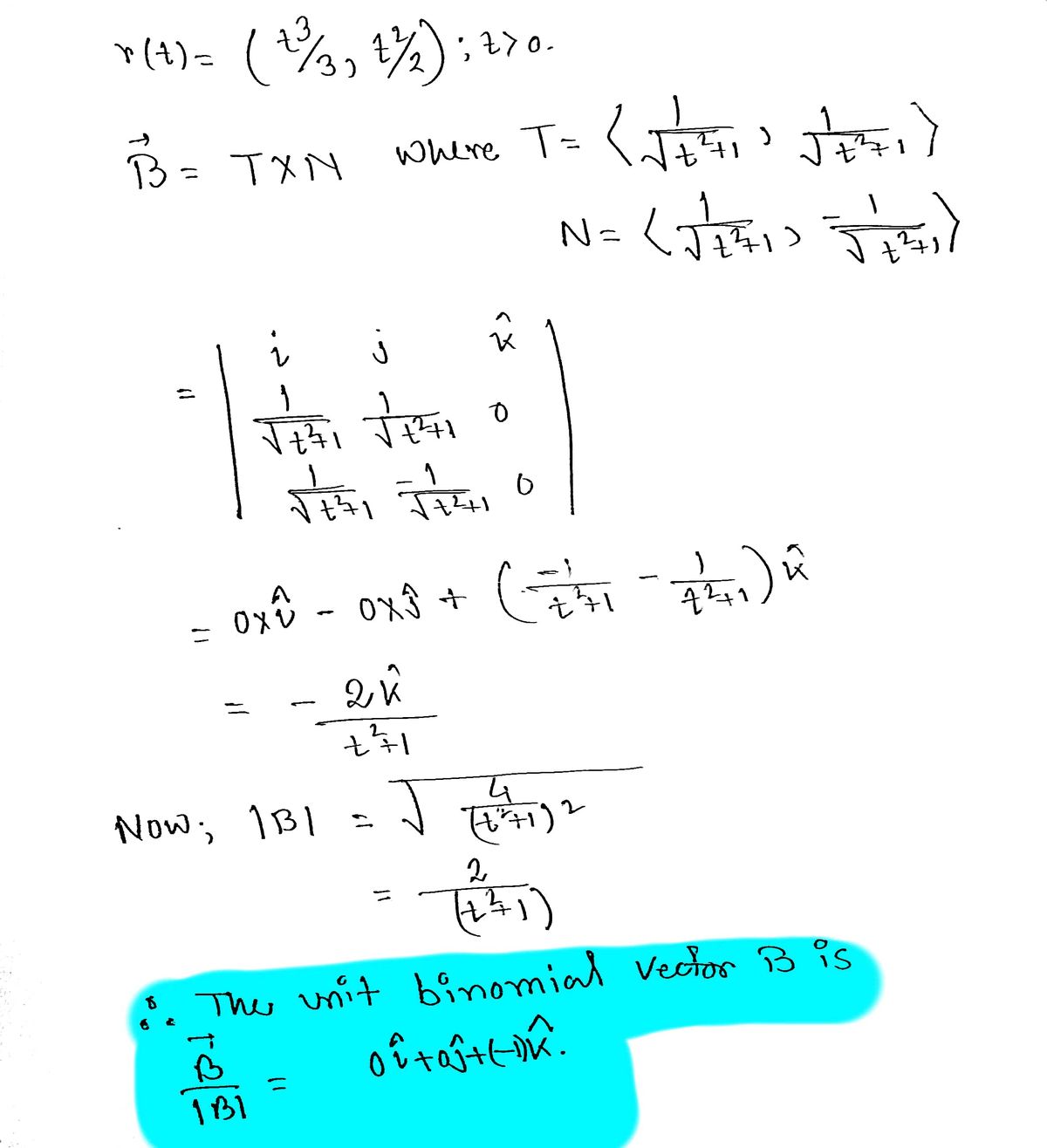The unit tangent vector T and the principal unit normal vector N for the parameterized curve r(t) = t>0, are shown below. Use the definitions to compute the unit binormal vector B and torsion t for r(t). T = N = +1 vt +1 +1 VP+1 ..... The unit binormal vector is B= (Type exact answers, using radicals as needed.)
The unit tangent vector T and the principal unit normal vector N for the parameterized curve r(t) = t>0, are shown below. Use the definitions to compute the unit binormal vector B and torsion t for r(t). T = N = +1 vt +1 +1 VP+1 ..... The unit binormal vector is B= (Type exact answers, using radicals as needed.)
Advanced Engineering Mathematics
10th Edition
ISBN:9780470458365
Author:Erwin Kreyszig
Publisher:Erwin Kreyszig
Chapter2: Second-order Linear Odes
Section: Chapter Questions
Problem 1RQ
Related questions
Question
100%
![The text presents a problem involving a parameterized curve \( r(t) = \left( \frac{t^3}{3}, \frac{t}{2} \right) \), for \( t > 0 \). The goal is to compute the unit binormal vector \( \mathbf{B} \) and torsion \( \tau \) for \( r(t) \).
The unit tangent vector \( \mathbf{T} \) and the principal unit normal vector \( \mathbf{N} \) are given as follows:
\[
\mathbf{T} = \left( \frac{t}{\sqrt{t^2 + 1}}, \, \frac{1}{\sqrt{t^2 + 1}} \right)
\]
\[
\mathbf{N} = \left( \frac{1}{\sqrt{t^2 + 1}}, \, -\frac{t}{\sqrt{t^2 + 1}} \right)
\]
The task is to calculate the unit binormal vector \( \mathbf{B} \). The solution requires finding the cross product of \( \mathbf{T} \) and \( \mathbf{N} \) to derive \( \mathbf{B} \).
Solution begins by finding:
\[
\mathbf{B} = \mathbf{T} \times \mathbf{N}
\]
(Type exact answers, using radicals as needed.)](/v2/_next/image?url=https%3A%2F%2Fcontent.bartleby.com%2Fqna-images%2Fquestion%2Fca46498c-9039-4635-914d-0b10c3becf43%2F86902ecd-7171-4971-8e30-9024cb65cb87%2F1qte9s_processed.jpeg&w=3840&q=75)
Transcribed Image Text:The text presents a problem involving a parameterized curve \( r(t) = \left( \frac{t^3}{3}, \frac{t}{2} \right) \), for \( t > 0 \). The goal is to compute the unit binormal vector \( \mathbf{B} \) and torsion \( \tau \) for \( r(t) \).
The unit tangent vector \( \mathbf{T} \) and the principal unit normal vector \( \mathbf{N} \) are given as follows:
\[
\mathbf{T} = \left( \frac{t}{\sqrt{t^2 + 1}}, \, \frac{1}{\sqrt{t^2 + 1}} \right)
\]
\[
\mathbf{N} = \left( \frac{1}{\sqrt{t^2 + 1}}, \, -\frac{t}{\sqrt{t^2 + 1}} \right)
\]
The task is to calculate the unit binormal vector \( \mathbf{B} \). The solution requires finding the cross product of \( \mathbf{T} \) and \( \mathbf{N} \) to derive \( \mathbf{B} \).
Solution begins by finding:
\[
\mathbf{B} = \mathbf{T} \times \mathbf{N}
\]
(Type exact answers, using radicals as needed.)
Expert Solution
Step 1

Step by step
Solved in 2 steps with 2 images

Recommended textbooks for you

Advanced Engineering Mathematics
Advanced Math
ISBN:
9780470458365
Author:
Erwin Kreyszig
Publisher:
Wiley, John & Sons, Incorporated

Numerical Methods for Engineers
Advanced Math
ISBN:
9780073397924
Author:
Steven C. Chapra Dr., Raymond P. Canale
Publisher:
McGraw-Hill Education

Introductory Mathematics for Engineering Applicat…
Advanced Math
ISBN:
9781118141809
Author:
Nathan Klingbeil
Publisher:
WILEY

Advanced Engineering Mathematics
Advanced Math
ISBN:
9780470458365
Author:
Erwin Kreyszig
Publisher:
Wiley, John & Sons, Incorporated

Numerical Methods for Engineers
Advanced Math
ISBN:
9780073397924
Author:
Steven C. Chapra Dr., Raymond P. Canale
Publisher:
McGraw-Hill Education

Introductory Mathematics for Engineering Applicat…
Advanced Math
ISBN:
9781118141809
Author:
Nathan Klingbeil
Publisher:
WILEY

Mathematics For Machine Technology
Advanced Math
ISBN:
9781337798310
Author:
Peterson, John.
Publisher:
Cengage Learning,

